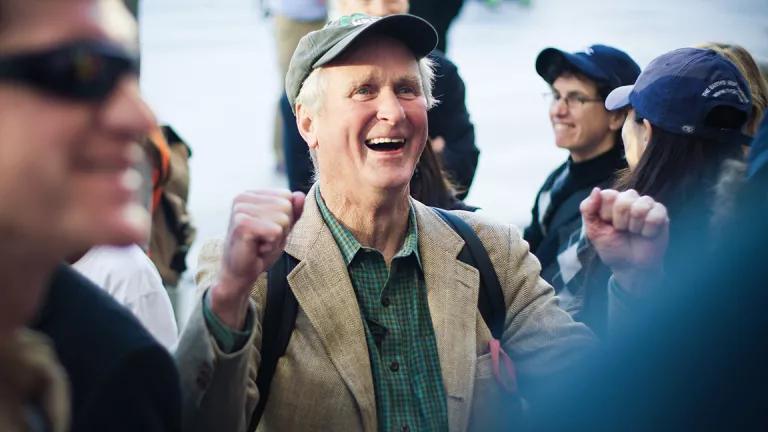The Man Behind the Mission
How a disgusting sight spurred John Adams to form the nation’s first litigation-focused environmental advocacy group.

John Adams (center) cheering during a protest in opposition to TransCanada's Keystone XL pipeline outside the White House in Washington, D.C., November 6, 2011
Josh Lopez/Tar Sands Action via Flickr, CC-BY 4.0
John Adams was sitting on a bench in Battery Park in New York City, lunching on a liverwurst sandwich, when he noticed lumps of raw sewage floating by on the Hudson River. The year was 1969, a momentous one in the history of American environmentalism. A massive offshore oil spill had recently blackened the beaches of Santa Barbara, California, and poisoned the area's marine life. On the Cuyahoga River in Ohio, an oil slick caught fire, sending flames five stories high. Citizens across the country were outraged by the reckless industrial pollution that went on unmonitored and unpunished, and politicians responded with new proposals to safeguard the air, water, and wildlife.
As Adams watched the waste soil the heart of the country’s largest city, he came to a realization: Laws to combat pollution would be a powerful tool. What the world needed now were lawyers to enforce them. That spark gave birth, about a year later, to the Natural Resources Defense Council—the first national environmental advocacy group to focus on bringing change through the courts. Inspired by the work of organizations like the NAACP and the ACLU, Adams, a former federal prosecutor and Wall Street attorney, enlisted like-minded lawyers from academia, public policy, and business to create a new field of public interest law dedicated exclusively to the benefit and protection of the natural world.
As NRDC’s first executive director and, later, its president, Adams supported his colleagues’ work to pass the Clean Water Act, phase out the use of lead in gasoline, curb acid rain emissions from coal-burning power plants, and protect the breeding grounds of gray whales near Baja California from industrial development. Fueled by a love of nature dating back to his childhood on a small farm in upstate New York, Adams spearheaded the crucial campaign to win the classification of greenhouse gases as pollutants under the Clean Air Act in 2007, a victory with far-reaching consequences as the world confronts climate change. These efforts haven’t gone ignored. In announcing his selection for the 2010 Presidential Medal of Freedom, the nation’s highest civilian honor, President Barack Obama cited Adams’s role at NRDC—which now has a staff of more than 500 lawyers and scientists as well as millions of members—as “unparalleled by the leader of any other environmental organization.”
Such accomplishments don’t come without a fight. From its early strategy sessions in the 1970s at the old farmhouse in the Catskill Mountains where John and his wife, Patricia, spent weekends to the opening of the organization’s seventh regional office in Beijing in 2006, NRDC often found itself on the offensive. Adams, a former member of the U.S. attorney’s strike force on organized crime and racketeering, cut his teeth as an environmental litigator by suing one of the nation’s largest utility companies to defeat a plan to carve out the interior of New York’s scenic Storm King Mountain to create a hydroelectric pumping station. During the Nixon administration, the IRS unsuccessfully challenged the organization’s ability to litigate in court while retaining its nonprofit status. NRDC went on to prevail in major battles to ban asbestos, win federal protection for 100 million acres of Alaska wilderness, and impose energy-efficiency standards for household appliances.
Describing Adams’s strategic vision as “infinitely pragmatic,” actor and NRDC board member Robert Redford wrote in the introduction of John and Patricia Adams’s memoir, A Force of Nature, “The message was, work with us to design solutions and we’ll do what we can to find common ground; oppose us and we will see you in court—and more often than not we will win.”
In 2006, after more than 35 years on the front lines of environmental advocacy, Adams stepped down from the leadership position of the pioneering organization he was instrumental in creating. But as founding director, he remains involved in NRDC’s key battles, especially our global fight to mitigate climate change. Today, litigation is just one of the many ways NRDC faces down challenges posed by pollution and threats to our natural resources. But one man’s eureka moment on a park bench in 1969 remains an inspiration. As a writer for Rolling Stone once put it, “If the planet has a lawyer, it's John Adams.”
This NRDC.org story is available for online republication by news media outlets or nonprofits under these conditions: The writer(s) must be credited with a byline; you must note prominently that the story was originally published by NRDC.org and link to the original; the story cannot be edited (beyond simple things such as grammar); you can’t resell the story in any form or grant republishing rights to other outlets; you can’t republish our material wholesale or automatically—you need to select stories individually; you can’t republish the photos or graphics on our site without specific permission; you should drop us a note to let us know when you’ve used one of our stories.

How to Become a Community Scientist
The Uinta Basin Railway Would Be a Bigger Carbon Bomb Than Willow
Biodiversity 101